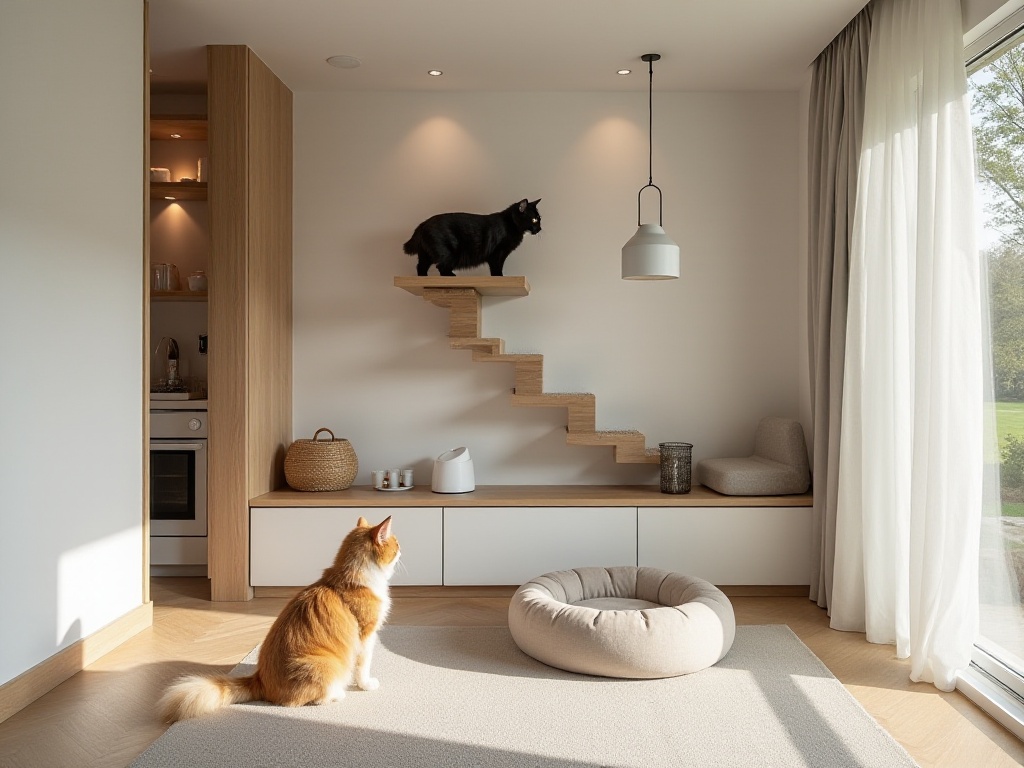Introduction
Whenever I see pet owners sharing their vet bills on social media, I can sense their frustration. As someone who has been keeping pets since college and now has 20 years of experience, I deeply understand this feeling. I remember when I first started keeping cats as a poor student, I would break into a cold sweat just looking at the veterinary clinic's price list. But over the years, I've gradually discovered many practical tips that not only keep my fur babies comfortable but have also saved me a lot of money. Now I'd like to share my accumulated experience with everyone, hoping to help more pet lovers.
Prevention First
When it comes to saving money on pet care, prevention is key. The logic is simple - just like with human illness, when minor ailments develop into serious conditions, not only does it cause suffering, but the costs also multiply. I particularly remember the example of my first cat, Little Gray. When I had just started working and wasn't financially stable, I still insisted on taking it for annual check-ups. During one routine examination, the doctor discovered its thyroid levels were slightly abnormal. Although Little Gray seemed energetic and showed no discomfort at the time, we followed the doctor's advice and started early intervention. Looking back, if we hadn't discovered this issue then, treating it after symptoms became obvious would have cost many times more.
Speaking of this, I must address the topic of vaccines. I often see new pet owners in various pet groups discussing whether indoor cats need vaccines. Many think: "My cat never goes outside or interacts with other cats, so they probably don't need vaccines, right?" This thinking is really dangerous. I'll never forget my friend's Ragdoll cat called Milk Candy, who wasn't vaccinated on schedule because they thought indoor cats didn't need it. During a home renovation, workers accidentally let a stray cat slip in. Who would have thought that such brief contact would lead to Milk Candy contracting feline panleukopenia. During that period, I watched my friend make daily hospital trips, spending nearly 80,000 yuan in total, fortunately managing to save the cat. However, Milk Candy's health was still affected and requires lifelong medication.
Actually, vaccines are like insurance for our furry friends. Although vaccines cost money, compared to treatment costs after illness, it's really nothing. I suggest setting aside money for annual vaccine expenses in advance, treating it as a special fund for your pets. Many veterinary clinics now offer annual check-up packages that usually include basic examinations and core vaccines, which are much cheaper than getting them separately.
Besides regular check-ups and vaccines, routine preventive measures are also crucial. For example, regular deworming is essential and shouldn't be skipped. I've seen too many cases of pets getting infected with various parasites due to irregular deworming. Internal and external deworming must be done regularly, especially for young cats and dogs. I usually set reminders on my phone to deworm my pets every three months. This way I won't forget and can ensure the effectiveness of deworming.
Diet Wisdom
When it comes to diet, this is where problems most easily occur, but it's also where you can save the most money. However, note that saving money here doesn't mean buying the cheapest food, but rather spending money wisely. I see many new pet owners trying to save money by buying very cheap pet food, not realizing this might lead to paying a higher price in the future.
My former neighbor is a typical example. They had a Golden Retriever and always bought dog food from the supermarket that cost only twenty or thirty yuan per pound. At first, the dog seemed to enjoy it, but before long it started having skin problems and frequent diarrhea. When they took it to the hospital, they found out it was due to malnutrition causing decreased immunity. Just treating these problems cost several thousand yuan. Later, following the doctor's advice, they switched to quality food. Although the food was more expensive, the dog's health condition improved significantly and similar problems never occurred again.
When choosing pet food, the most important thing is to look at the ingredient list. Don't be fooled by flashy advertising on the packaging; check if it meets AAFCO standards. Although this standard sounds professional, it simply ensures the food contains all necessary nutrients pets need. Specifically, look at whether the protein, fat, carbohydrate, vitamin, and mineral content is balanced.
For dogs that eat too quickly, I have a particularly useful trick. Place a rubber ball about the size of a tennis ball in their food bowl. This forces the dog to eat around the ball and prevents them from swallowing all the food at once. I've used this method for many years with great results. It not only prevents digestive problems caused by eating too fast but also adds some mental stimulation during mealtime.
Then there's the issue of portion size. Many people think their pets are too thin and keep overfeeding them. This actually leads to many health problems. I strictly follow the recommended portions on the food packaging and adjust based on the pet's body condition and activity level. If you're really worried about nutrition, you can add some fresh meat or vegetables, but be sure to check food safety.
Water is also very important. I've noticed many pets don't like drinking water, often because the water bowl is in the wrong place or the water isn't fresh enough. I place several water bowls in different locations around the house. I also change the water frequently to ensure freshness. There are many water fountains available now, and while they require an initial investment, they're very convenient and encourage pets to drink more water, making them worthwhile in the long run.
Environment Setup
Environmental setup may seem simple, but it's crucial for pets' physical and mental health. Good environmental setup not only makes pets more comfortable but also prevents many accidents.
Let's start with outdoor pet environments. Many people who keep outdoor dogs face the problem of food and water bowls being knocked over. This not only wastes food and water but also makes the ground messy. My solution is simple: find an old tire and place the food and water bowls inside it. This not only prevents bowls from tipping over but also keeps them off the ground in winter to prevent freezing. I've used this method for several years with great results. Most importantly, it costs nothing - just find an old tire.
For indoor pets, environmental enrichment is particularly important. But this doesn't mean you need to spend a lot of money on toys. Many common household items can become pet toys. For example, cardboard boxes are heaven for cats. After receiving deliveries, I always keep the boxes for my cats to play with. Cut a few holes, sprinkle some catnip, and cats will have endless fun.
In summer, my favorite "poor man's trick" is freezing treats or toys in ice blocks. The method is simple: place some small treats or toys in large ice cube trays, add water, and freeze. Once frozen, place the ice blocks in a large dish for pets to play with. They'll lick the ice to get to the treats inside, which provides both entertainment and cooling. Breeds that don't tolerate heat well, like Huskies, especially love this.
Then there's the cat tree issue. Commercial cat trees can cost hundreds or thousands, and quality varies greatly. You can actually make one yourself. Find some wooden boards and rope, buy some screws and tools, and assemble a sturdy cat tree that's both economical and durable. The cat tree I made has been used for over three years and is still my cats' favorite spot.
Speaking of cat trees, we can't ignore scratching issues. Many people buy expensive scratching posts to prevent cats from scratching furniture. Actually, you can make a good scratching post by wrapping rope around a wooden board. I also sprinkle some catnip on it to encourage cats to scratch there.
For dogs, the most important thing is having a comfortable sleeping area. You don't need to buy those hundreds-of-yuan dog beds; find a suitable-sized cardboard box and line it with soft blankets. The key is placing it in a quiet, undisturbed location to give the dog their own private space.
Cleaning Tips
One of the most headache-inducing aspects of pet ownership is cleaning. Especially dealing with shedding and various stains - if not handled properly, it not only makes the house dirty but can also affect family members' health.
Let's start with the troublesome shedding issue. I used to buy various specialized pet hair removal tools, but none were particularly effective. Later I discovered a very practical method: wear disposable latex gloves and directly wipe the surface that needs cleaning. Amazingly, the fur sticks to the gloves due to static electricity. This method is especially suitable for cleaning sofas, carpets, and other hard-to-clean places. Plus, disposable gloves are very cheap and one box lasts a long time.
Besides the glove method, I also regularly vacuum. However, note that ordinary vacuum cleaners might not be suitable for pet hair as they can clog easily. If you frequently need to deal with pet hair, consider buying a vacuum with a specialized pet hair attachment. Although the initial investment is larger, it's worth it in the long run.
Dealing with urine stains is another headache. Many people buy specialized pet odor removers, but actually, some common household materials can solve the problem. My recipe is: baking soda plus white vinegar. The specific method is: first absorb the urine with paper towels, then spray the stain with a solution of equal parts water and white vinegar, finally sprinkle a layer of baking soda on top. After it's completely dry, vacuum up the baking soda. This method not only removes odors but also thoroughly cleans stains.
For litter box cleaning, I have a trick. Place a large garbage bag at the bottom of the litter box before adding cat litter. When cleaning, just lift out the garbage bag. It's both hygienic and convenient. Plus, garbage bags are cheap and one roll lasts a long time.
Then there's the issue of regular pet cleaning. Many people think pets need frequent baths, but this view is incorrect. Unless pets are really dirty or need medicated baths for skin conditions, frequent bathing isn't necessary. Over-washing can actually damage pets' skin barrier. I usually just wipe with a damp cloth and regularly brush their fur.
Speaking of fur brushing, I've noticed many people don't know how to choose brushes. Different fur types need different brushes. For example, long-haired cats and dogs need a combination of pin brush and slicker brush, while short-haired pets just need a rubber brush. Choosing the right tools not only makes brushing more effective but also makes it enjoyable for pets.

Seasonal Care
Different seasons require different care methods. Many health issues actually come from seasonal changes - with good prevention, you can avoid many unnecessary medical expenses.
In winter, the most common problem is cracked paws. Especially in northern regions, dry weather plus road de-icing agents can easily hurt dogs' paws. My solution is simple: apply some petroleum jelly. This method is cheap and safe, and works very well. After each walk, I clean their paws with a damp cloth, then apply a thin layer of petroleum jelly.
Then there's the winter warmth issue. Many people buy various expensive clothes for their pets, but this isn't necessary. As long as indoor temperature is appropriate and they have a warm bed, that's enough. I put a hot water bottle wrapped in a towel in their bed - it's both warm and safe.
In summer, cooling becomes the focus. I have a very popular "cooling snack" recipe: blend chicken broth with some fruits and vegetables, then freeze in ice cube trays. This not only helps pets cool down but also provides nutrition. For example, carrots are rich in vitamin A, and watermelon is high in water content - both are good choices. This is much more economical than buying specialized pet treats.
Summer also requires special attention to mosquito and insect prevention. I grow some insect-repelling plants at home, like mint and lemongrass. This is both eco-friendly and practical, plus it beautifies the environment. If insects are really bad, you can use specialized pet insect repellent sprays, but be sure to choose safe products.
Spring and fall are peak shedding seasons. During these times, it's essential to increase brushing to help pets complete their coat change quickly. I usually prepare a specific brushing schedule and brush at fixed times daily. This not only reduces fur around the house but also helps catch skin problems early.

Behavior Management
When it comes to behavior management, this might be the least expensive but most patience-requiring part. Many people send their pets to training schools when behavior problems arise, but actually many issues can be solved at home.
The scariest thing when walking dogs is when they suddenly run away. I discovered a particularly effective method: if your dog runs away, don't chase them - instead, lie down and pretend to be injured. Most dogs will worry and run back when they see their owner like this. I've used this method many times, and it works every time. The principle is simple - it utilizes dogs' attachment to their owners.
However, note that this method requires building a good relationship with your dog beforehand. I often play games with my dogs, like hide-and-seek or toy finding, to increase their attachment to me. This way, the method will be effective when needed.
Another practical dog-walking tip: use a carabiner to attach the leash to your belt. This not only frees your hands but also lets the dog feel more stable pulling force. Plus, if the dog suddenly pulls hard, the force point is at your waist, which is more stable than holding with your hands.
For cats, the most common behavior problems are scratching and inappropriate urination. These problems are usually caused by stress or territorial instincts. My solution is: prepare several litter boxes and scratching posts, placed in different locations around the house. This way cats can find appropriate places to express their natural behaviors without destroying furniture.
Another common issue is nighttime disturbances. Many cats are especially active at night, often keeping their owners awake. My method is: schedule an interactive play session before bedtime to help cats burn off excess energy. Then prepare some self-play toys, like automatic cat teasers or puzzle balls, so they can play by themselves while we sleep.

Daily Medical Care
Good daily medical care can prevent many unnecessary medical expenses. Many people think providing medical care for pets is particularly difficult, but actually it's not hard at all if you master the correct methods.
Let's start with the basic issue of teeth brushing. Many people find brushing dogs' teeth particularly difficult, but here's a different approach: spread specialized dog toothpaste on their favorite toys, letting them brush their teeth while playing. The effect might not be perfect at first, but with persistence, dogs will gradually get used to it.
I also regularly check dogs' teeth and gums. If I notice tartar or gum inflammation, I take them to the hospital promptly. Although preventive dental cleaning costs money, it's much cheaper than treating serious dental disease later.
Nail trimming is another challenge. Many pets strongly resist nail trimming, but this problem can also be easily solved with the right method. My trick is: spread some peanut butter on the bathtub wall. Dogs will focus on licking the peanut butter, giving you a chance to trim their nails. Of course, start gradually - first let them get used to you touching their paws, then slowly start trimming.
For breeds prone to skin problems, I regularly check their skin condition. Especially in places that easily collect dirt like ears and between paws. Addressing problems promptly prevents them from developing into serious skin conditions.
Then there's the issue of regular weighing. Weight changes are often early signals of many diseases. I weigh my pets monthly and keep records. If I notice abnormal weight fluctuations, I take them to the hospital promptly for a check-up.

Conclusion
Keeping pets indeed requires investment, but with the right methods, you can spend money wisely. The most important thing is careful observation - many seemingly complex problems can be solved with simple methods. Remember, saving money isn't the goal; keeping pets healthy and happy is what matters most. Over these years, through these methods, I've not only saved money but more importantly helped my fur babies live better lives. I hope these experiences can help more pet owners.


